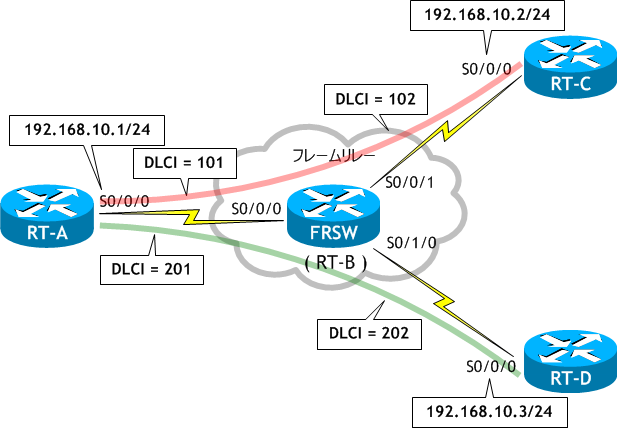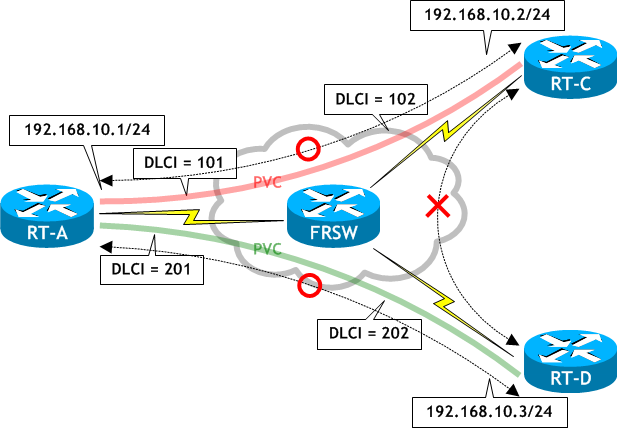フレームリレーを設定する (ハブ & スポーク)
ネットワーク構成図

- RT-B に FRSW という名前を付け、ネットワーク構成図を参考に、フレームリレースイッチとして構成しなさい。
- ネットワーク構成図に従い、RT-A、RT-C、RT-D でフレームリレーを構成しなさい。
- 全てのルータ間で ping を実施しなさい。
- RT-A、RT-C、RT-D で sh frame-relay map を実行し、フレームリレーマップを確認しなさい。
- RT-C と RT-D 間で通信ができるように手動でマップエントリを設定しなさい。
- RT-C と RT-D で sh frame-relay map を実行し、フレームリレーマップを確認しなさい。
- RT-C と RT-D 間で ping を実施しなさい。
< RT-B > Router# conf t Enter configuration commands, one per line. End with CNTL/Z. Router(config)# host FRSW FRSW(config)# frame-relay switching FRSW(config)# int s0/0/0 FRSW(config-if)# description to RT-A FRSW(config-if)# no ip address FRSW(config-if)# clock rate 64000 FRSW(config-if)# encap frame-relay FRSW(config-if)# frame-relay intf-type dce FRSW(config-if)# frame-relay route 101 int s0/0/1 102 FRSW(config-if)# frame-relay route 201 int s0/1/0 202 FRSW(config-if)# no shut FRSW(config-if)# int s0/0/1 FRSW(config-if)# description to RT-C FRSW(config-if)# no ip address FRSW(config-if)# clock rate 64000 FRSW(config-if)# encap frame-relay FRSW(config-if)# frame-relay intf-type dce FRSW(config-if)# frame-relay route 102 int s0/0/0 101 FRSW(config-if)# no shut FRSW(config-if)# int s0/1/0 FRSW(config-if)# description to RT-D FRSW(config-if)# no ip address FRSW(config-if)# clock rate 64000 FRSW(config-if)# encap frame-relay FRSW(config-if)# frame-relay intf-type dce FRSW(config-if)# frame-relay route 202 int s0/0/0 201 FRSW(config-if)# no shut FRSW(config-if)# ^Z FRSW#
フレームリレースイッチの構成は CCNA の範囲外です。
< RT-A > Router# conf t Enter configuration commands, one per line. End with CNTL/Z. Router(config)# host RT-A RT-A(config)# int s0/0/0 RT-A(config-if)# ip add 192.168.10.1 255.255.255.0 RT-A(config-if)# encapsulation frame-relay RT-A(config-if)# no shut RT-A(config-if)# ^Z RT-A#
< RT-C > Router# conf t Enter configuration commands, one per line. End with CNTL/Z. Router(config)# host RT-C RT-C(config)# int s0/0/0 RT-C(config-if)# ip add 192.168.10.2 255.255.255.0 RT-C(config-if)# encapsulation frame-relay RT-C(config-if)# no shut RT-C(config-if)# ^Z RT-C#
< RT-D > Router# conf t Enter configuration commands, one per line. End with CNTL/Z. Router(config)# host RT-D RT-D(config)# int s0/0/0 RT-D(config-if)# ip add 192.168.10.3 255.255.255.0 RT-D(config-if)# encapsulation frame-relay RT-D(config-if)# no shut RT-D(config-if)# ^Z RT-D#
< RT-A > RT-A# ping 192.168.10.2 ← RT-C への ping Type escape sequence to abort. Sending 5, 100-byte ICMP Echos to 192.168.10.2, timeout is 2 seconds: !!!!! ← 成功 Success rate is 100 percent (5/5), round-trip min/avg/max = 56/58/60 ms RT-A# ping 192.168.10.3 ← RT-D への ping Type escape sequence to abort. Sending 5, 100-byte ICMP Echos to 192.168.10.3, timeout is 2 seconds: !!!!! ← 成功 Success rate is 100 percent (5/5), round-trip min/avg/max = 56/57/60 ms RT-A#
< RT-C > RT-C# ping 192.168.10.1 ← RT-A への ping Type escape sequence to abort. Sending 5, 100-byte ICMP Echos to 192.168.10.1, timeout is 2 seconds: !!!!! ← 成功 Success rate is 100 percent (5/5), round-trip min/avg/max = 56/58/61 ms RT-C# RT-C# ping 192.168.10.3 ← RT-D への ping Type escape sequence to abort. Sending 5, 100-byte ICMP Echos to 192.168.10.3, timeout is 2 seconds: ..... ← 失敗 Success rate is 0 percent (0/5) RT-C#
< RT-D > RT-D# ping 192.168.10.1 ← RT-A への ping Type escape sequence to abort. Sending 5, 100-byte ICMP Echos to 192.168.10.1, timeout is 2 seconds: !!!!! ← 成功 Success rate is 100 percent (5/5), round-trip min/avg/max = 56/57/61 ms RT-D# RT-D# ping 192.168.10.2 ← RT-C への ping Type escape sequence to abort. Sending 5, 100-byte ICMP Echos to 192.168.10.2, timeout is 2 seconds: ..... ← 失敗 Success rate is 0 percent (0/5) RT-D#
< RT-A > RT-A# sh frame-relay map Serial0/0/0 (up): ip 192.168.10.2 dlci 101(0x65,0x1850), dynamic, ← RT-C 宛て broadcast,, status defined, active Serial0/0/0 (up): ip 192.168.10.3 dlci 201(0xC9,0x3090), dynamic, ← RT-D 宛て broadcast, CISCO, status defined, active RT-A#
< RT-C >
RT-C# sh frame-relay map
Serial0/0/0 (up): ip 192.168.10.1 dlci 102(0x66,0x1860), dynamic, ← RT-A 宛て
broadcast,
CISCO, status defined, active
RT-C#
< RT-D >
RT-D# sh frame-relay map
Serial0/0/0 (up): ip 192.168.10.1 dlci 202(0xCA,0x30A0), dynamic, ← RT-A 宛て
broadcast,, status defined, active
RT-D#
RT-A には、RT-C、RT-D 宛てのマップエントリがありますが、RT-C と RT-D には、RT-A までのマップエントリしかありません。Inverse ARP では 直接 PVC のない RT-C と RT-D 間で通信するためのマップエントリが自動で作成されませんので、frame-relay map コマンドを使って手動で設定する必要があります。
< RT-C > RT-C# conf t Enter configuration commands, one per line. End with CNTL/Z. RT-C(config)# int s0/0/0 RT-C(config-if)# frame-relay map ip 192.168.10.3 102 RT-C(config-if)# ^Z RT-C#
< RT-D > RT-D# conf t Enter configuration commands, one per line. End with CNTL/Z. RT-D(config)# int s0/0/0 RT-D(config-if)# frame-relay map ip 192.168.10.2 202 RT-D(config-if)# ^Z RT-D#
RT-C、RT-D それぞれに、相手側のルータに行くためのマップエントリを追加しました。
< RT-C >
RT-C# sh frame-relay map
Serial0/0/0 (up): ip 192.168.10.3 dlci 102(0x66,0x1860), static, ← RT-D 宛て
CISCO, status defined, active
Serial0/0/0 (up): ip 192.168.10.1 dlci 102(0x66,0x1860), dynamic,
broadcast,
CISCO, status defined, active
RT-C#
< RT-D >
RT-D# sh frame-relay map
Serial0/0/0 (up): ip 192.168.10.2 dlci 202(0xCA,0x30A0), static, ← RT-C 宛て
CISCO, status defined, active
Serial0/0/0 (up): ip 192.168.10.1 dlci 202(0xCA,0x30A0), dynamic,
broadcast,, status defined, active
RT-D#
RT-C、RT-D それぞれ、直接 PVC のある RT-A 宛ては Inverse ARP で動的 (dynamic) に生成し、動的に生成できない相手へのルートは RT-A 経由でフレームが送られるように静的 (static) に設定しました。
< RT-C >
RT-C# ping 192.168.10.3
Type escape sequence to abort.
Sending 5, 100-byte ICMP Echos to 192.168.10.3, timeout is 2 seconds:
!!!!! ← 成功
Success rate is 100 percent (5/5), round-trip min/avg/max = 112/116/124 ms
RT-C#
< RT-D >
RT-D# ping 192.168.10.2
Type escape sequence to abort.
Sending 5, 100-byte ICMP Echos to 192.168.10.2, timeout is 2 seconds:
!!!!! ← 成功
Success rate is 100 percent (5/5), round-trip min/avg/max = 112/116/124 ms
RT-D#
RT-C と RT-D 間は RT-A 経由で通信していますので、応答に時間がかかります。round-trip を参照。
